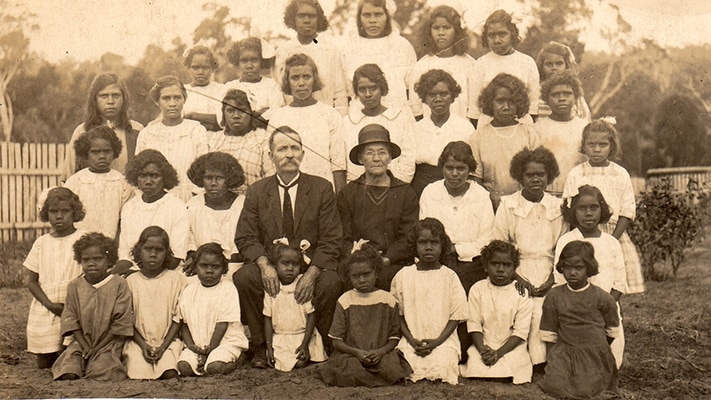
The following story is based on a longer article from the Encyclopedia of Seventh-day Adventists (ESDA) that can be accessed online for free, along with approximately 2,500 additional articles, at encyclopedia.adventist.org.—Editors.
Aboriginal and Torres Strait Islander Ministries (ATSIM) is a department of the Australian Union Conference that gives priority to the ministry of the Seventh-day Adventist Church among the indigenous peoples of Australia.
Early Seventh-day Adventist Missionary Endeavors
The antecedents of formal ministry among Aboriginal peoples can be traced to the appointment of Phillip Rudge to evangelistic ministry in Kempsey and the Macleay Valley region in New South Wales, somewhere near the end of the first decade of the twentieth century. Rudge began to work among the Aboriginal people from the Burnt Bridge Settlement, and later the Barambah Aboriginal Settlement, located near Murgon, Queensland.
Monamona Mission
![Pastor James Brandford and his wife pose with students of the Monamona mission school. [Courtesy of Stephen Piez]](https://adventistreview.org/wp-content/uploads/2022/01/sb_Pastor-and-Mrs-Brandford-with-Mona-Mona-students-PicB.jpg) At the 1912 August-September Australasian Union Conference council meetings, it was agreed to establish an Adventist Aboriginal mission in North Queensland.1 In early January 1913, Rudge traveled to North Queensland with James Brandford (vice president of Queensland Conference) to inspect possible sites.2 They met with many Aboriginal people and became increasingly aware of the great hardships most suffered.
At the 1912 August-September Australasian Union Conference council meetings, it was agreed to establish an Adventist Aboriginal mission in North Queensland.1 In early January 1913, Rudge traveled to North Queensland with James Brandford (vice president of Queensland Conference) to inspect possible sites.2 They met with many Aboriginal people and became increasingly aware of the great hardships most suffered.
Rudge and Brandford located a 4,000-acre property not far from Kuranda on the banks of the Barron River.3 The new mission, which became known as Monamona, officially opened toward the end of 1913. The mission school began operation in early 1914 with seven pupils.4 The new mission commenced operation with the full support of Queensland’s chief protector of Aborigines. This endorsement was unique as chief protectors from other states were openly antagonistic to church involvement in Aboriginal affairs.
In addition to the successful education program and food gardens, Monamona began a sawmill to help supplement income and provide timber for the building program. Many Aboriginal people from the surrounding area chose to make Monamona their permanent home.
Following Queensland’s lead, other missions were organized in Western Australia and New South Wales. Among these missions were Karalundi, Wiluna, and Mullewa missions.
Beginning in the 1960s, many church-run missions for indigenous Australians faced significant difficulties maintaining underfunded programs in the face of increasing government demands. Monamona was the first to close in 1962.
The Birth of Aboriginal and Torres Strait Islander Ministries (ATSIM)
In 1975, Ronald Taylor became secretary of the South Pacific Division. Taylor envisioned a church-sponsored national work. The South Pacific Division executive committee voted to reorganize Aboriginal outreach. The first thing they did was send out a survey to as many Aboriginal members as possible, asking what each wanted the church to do for them. This was followed by visits to places such as Kempsey, Mackay, Cairns, Darwin, Alice Springs, and Western Australia. Aboriginal people wanted the church to establish a department that focused solely on ministry to indigenous Australians.
![The Lighbearer II, was a church-owned vessel used for ministry in the Torres Strait Islands, Northern Australia Conference. [Courtesy of Barry Oliver]](https://adventistreview.org/wp-content/uploads/2022/01/sb_Lightbearer-Church-vessel-used-for-ministry-in-the-Torres-Strait-PicB.jpg) A former missionary pilot in Papua New Guinea, Bruce Roberts, was appointed in 1980 to direct the venture. Roberts soon realized that Torres Strait islanders faced many of the same issues as did Aboriginals. Church leaders agreed to officially change the name of the Aboriginal Ministries Department to Aboriginal and Torres Strait Islander Ministries, or ATSIM.5
A former missionary pilot in Papua New Guinea, Bruce Roberts, was appointed in 1980 to direct the venture. Roberts soon realized that Torres Strait islanders faced many of the same issues as did Aboriginals. Church leaders agreed to officially change the name of the Aboriginal Ministries Department to Aboriginal and Torres Strait Islander Ministries, or ATSIM.5
Since the beginnings of the nationally coordinated ATSIM program in 1980, a number of achievements stand out. One such achievement was the publication of the Good News magazine. It continues to focus on reconnecting indigenous Australians and providing spiritual guidance and lifestyle advice.
Another significant achievement was the reopening of Karalundi. Aboriginal people gave many reasons for wanting to reopen Karalundi, including superior academic and spiritual education.6 Mamarapha College originally began as ATSIM Bible College in 1997. Graduates have been employed as full-time pastors, church-sponsored Bible workers, and self-supporting volunteers.
ATSIM required a new approach to sustain the growth into the future. To this end, ATSIM directors were appointed in every conference except Tasmania. ATSIM is widely recognized as the fastest-growing ministry in Australia.
Stephen Piez, M.Prof., is the former director of Aboriginal and Torres Strait Islander Ministries for the Australian Union Conference of the Seventh-day Adventist Church, Melbourne Australia. He has also served the Adventist Church as a pastor, administrator, and teacher.
1 Selwyn Hawken, “Monamona to 1929,” unpublished document, Northern Australia Conference of the Seventh-day Adventist Church Archives, Aitkenvale, Queensland, p. 2.
2 “Brethren Rudge and Brandford ...,” Australasian Record, January 20, 1913.
3 Hawken, p. 2.
4 Glynn Litster, “The Aborigines,” in Seventh-day Adventists in the South Pacific, ed. Noel Clapham (Warburton, Victoria: Signs Pub. Co., 1985), p. 188.
5 Bruce Roberts, phone interview by author, Ringwood, Victoria, May 31, 2007.
6 “Karalundi Petitions,” 1985, unpublished documents held in the personal collection of the author.